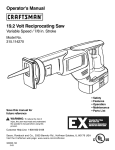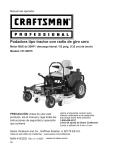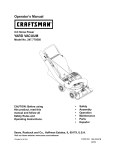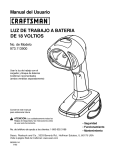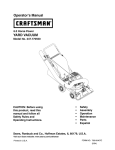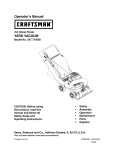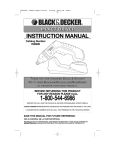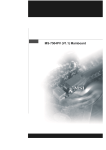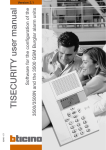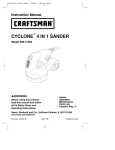Download Craftsman 900.11458 Instruction manual
Transcript
5147391-00,01,11458 Revised 1/31/06 2:24 PM Page 1 Instruction Manual IMPACT SCREWDRIVER Model 900.11458 CAUTION: Before using this product, read this manual and follow all its Safety Rules and Operating Instructions. • • • • Safety Operation Maintenance Español, p. 8 Sears, Roebuck and Co., Hoffman Estates, IL 60179 U.S.A. www.sears.com/craftsman Form No. 5147391-00 Rev. 1 Jan. ‘06 Printed in China 5147391-00,01,11458 Revised 1/31/06 2:24 PM Page 2 IMPACT SCREWDRIVER DIAGRAM C B D A A B C D - Quick Release Collar - Pivot Button - Charging Port - Forward / Reverse Switch CRAFTSMAN WARRANTY ONE YEAR FULL WARRANTY ON CRAFTSMAN TOOL If this Craftsman tool fails to give complete satisfaction within one year from date of purchase, RETURN IT TO ANY SEARS STORE OR OTHER CRAFTSMAN OUTLET IN THE UNITED STATES FOR FREE REPLACEMENT. If this Craftsman tool is used for commercial or rental purposes, this warranty applies for only 90 days from thae date of purchase. This warranty gives you specific legal rights, and you may also have other rights which vary from state to state. Sears, Roebuck and Co., Dept. 817WA, Hoffman Estates, IL 60179 WARNING: IMPORTANT SAFETY WARNINGS AND INSTRUCTIONS TO REDUCE RISK OF INJURY: WARNING: When using electric tools, basic safety precautions should always be followed to reduce risk of fire, electric shock, and personal injury, including the following: • Before any use, be sure everyone using this tool reads and understands all safety instructions and other information contained in this manual. • Save these instructions and review frequently prior to use and in instructing others. READ ALL INSTRUCTIONS. GENERAL SAFETY RULES AND - FOR ALL BATTERY OPERATED TOOLS • Do not operate power tools in explosive atmospheres, such as in the presence of flammable liquids, gases, or dust. Power tools create sparks which may ignite the dust or fumes. • Keep bystanders, children, and visitors away while operating a power tool. Distractions can cause you to lose control. WARNING: READ AND UNDERSTAND ALL INSTRUCTIONS. Failure to follow all instructions listed below, may result in electric shock, fire and/or serious personal injury. SAVE THESE INSTRUCTIONS Work Area • Keep your work area clean and well lit. Cluttered benches and dark areas invite accidents. 2 5147391-00,01,11458 Revised 1/31/06 2:24 PM Page 3 do the job better and safer at the rate for which it is designed. • Do not use tool if switch does not turn it on or off. A tool that cannot be controlled with the switch is dangerous and must be repaired. • Disconnect battery pack from tool or place the switch in the locked or off position before making any adjustments, changing accessories, or storing the tool. Such preventive safety measures reduce the risk of starting the tool accidentally. • Store idle tools out of reach of children and other untrained persons. Tools are dangerous in the hands of untrained users. • When battery pack is not in use, keep it away from other metal objects like: paper clips, coins, keys, nails, screws or other small metal objects that can make a connection from one terminal to another. Shorting the battery terminals together may cause sparks, burns, or a fire. • Maintain tools with care. Keep cutting tools sharp and clean. Properly maintained tools, with sharp cutting edges are less likely to bind and are easier to control. • Check for misalignment or binding of moving parts, breakage of parts, and any other condition that may affect the tool’s operation. If damaged, have the tool serviced before using. Many accidents are caused by poorly maintained tools. • Use only accessories that are recommended by the manufacturer for your model. Accessories that may be suitable for one tool may create a risk of injury when used on another tool. Service • Tool service must be performed only by qualified repair personnel. Service or maintenance performed by unqualified personnel may result in a risk of injury. • When servicing a tool, use only identical replacement parts. Follow instructions in the Maintenance section of this manual. Use of unauthorized parts or failure to follow Maintenance Instructions may create a risk of shock or injury. Electrical Safety • A battery operated tool with integral batteries or a separate battery pack must be recharged only with the specified charger for the battery. A charger that may be suitable for one type of battery may create a risk of fire when used with another battery. • Use battery operated tool only with specifically designated battery pack. Use of any other batteries may create a risk of fire. Personal Safety • Stay alert, watch what you are doing and use common sense when operating a power tool. Do not use tool while tired or under the influence of drugs, alcohol, or medication. A moment of inattention while operating power tools may result in serious personal injury. • Dress properly. Do not wear loose clothing or jewelry. Contain long hair. Keep your hair, clothing, and gloves away from moving parts. Loose clothes, jewelry, or long hair can be caught in moving parts. • Avoid accidental starting. Be sure switch is in the locked or off position before inserting battery pack. Carrying tools with your finger on the switch or inserting the battery pack into a tool with the switch on invites accidents. • Remove adjusting keys or wrenches before turning the tool on. A wrench or a key that is left attached to a rotating part of the tool may result in personal injury. • Do not overreach. Keep proper footing and balance at all times. Proper footing and balance enable better control of the tool in unexpected situations. • Use safety equipment. Always wear eye protection. Dust mask, non-skid safety shoes, hard hat, or hearing protection must be used for appropriate conditions. Tool Use and Care • Use clamps or other practical ways to secure and support the workpiece to a stable platform. Holding the work by hand or against your body is unstable and may lead to loss of control. • Do not force tool. Use the correct tool for your application. The correct tool will 3 5147391-00,01,11458 Revised 1/31/06 2:24 PM Page 4 contact hidden wiring. Contact with a "live" wire will also make exposed metal parts of the tool "live" and shock the operator. Specific Safety Rules • Hold tool by insulated gripping surfaces when performing an operation where the cutting tool may The label on your tool may include the following symbols. V ..........................volts A ......................amperes Hz ........................hertz W ....................watts min ........................minutes ....................alternating current no ....................no load speed ......................direct current ..........................Class II Construction ....................earthing terminal ..............................safety alert symbol .../min ..............revolutions or reciprocations per minute specially designed to filter out WARNING: Some dust created by microscopic particles. power sanding, sawing, grinding, • Avoid prolonged contact with dust drilling, and other construction from power sanding, sawing, activities contains chemicals known to grinding, drilling, and other cause cancer, birth defects or other construction activities. Wear reproductive harm. Some examples of protective clothing and wash these chemicals are: exposed areas with soap and water. • lead from lead-based paints, Allowing dust to get into your mouth, eyes, or lay on the skin may promote • crystalline silica from bricks and cement absorption of harmful chemicals. and other masonry products, and WARNING: Use of this tool can • arsenic and chromium from generate and/or disburse dust, which chemically-treated lumber (CCA). may cause serious and permanent Your risk from these exposures varies, respiratory or other injury. Always use depending on how often you do this type of NIOSH/OSHA approved respiratory work. To reduce your exposure to these protection appropriate for the dust chemicals: work in a well ventilated area, exposure. Direct particles away from face and work with approved safety equipment, and body. such as those dust masks that are SAFETY WARNINGS AND INSTRUCTIONS: CHARGING 1. This manual contains important safety and operating instructions. 2. Before using battery charger, read all instructions and cautionary warnings on battery charger and product using battery. CAUTION: To reduce the risk of injury, use charger only with this product. Batteries in other products may burst causing personal injury or damage. 3. Do not expose charger to rain or snow. 4. Use of an attachment not recommended or sold by Sears may result in a risk of fire, electric shock, or injury to persons. 5. To reduce risk of damage to electric plug and cord, pull by plug rather than cord when disconnecting charger. 6. Make sure cord is located so that it will not be stepped on, tripped over, or otherwise subjected to damage or stress. 7. An extension cord should not be used unless absolutely necessary. Use of improper extension cord could result in a risk of fire, electric shock or electrocution. a. Two-wire cords can be used with 2-wire or 3-wire extension cords. Only round jacketed extension cords should be used, and we recommend that they be listed by Underwriters Laboratories (U.L.). If the extension is to be used outside, the cord must be suitable for outdoor use. Any cord marked for outdoor use can also be used for indoor work. The letters "W" or "WA" on the cord jacket indicate that the cord is suitable for outdoor use. b. An extension cord must have adequate wire size (AWG or American Wire Gauge) for safety, and to prevent loss of power and overheating. The smaller the gauge number of the wire, the greater the capacity of the cable; 4 5147391-00,01,11458 Revised 1/31/06 2:24 PM that is, 16 gauge has more capacity than 18 gauge. When using more than one extension to make up the Page 5 total length, be sure each extension contains at least the minimum wire size for the total length. Minimum Gage for Cord Sets Volts Total Length of Cord in Feet 120V 0-25 26-50 51-100 101-150 240V 0-50 51-100 101-200 201-300 Ampere Rating More Not more American Wire Gage Than Than 0 - 6 18 16 16 14 6 - 10 18 16 14 12 10 - 12 16 16 14 12 12 - 16 14 12 Not Recommended usage, charging or temperature conditions. This does not indicate a failure. However, if the outer seal is broken and this leakage gets on your skin: a. Wash quickly with soap and water. b. Neutralize with a mild acid such as lemon juice or vinegar. c. If the battery liquid gets in your eyes, flush them with clean water for a minimum of 10 minutes and seek immediate medical attention. MEDICAL NOTE: The liquid is a 25-35% solution of potassium hydroxide. 8. Use only the supplied charger when charging your tool. The use of any other charger could damage the screwdriver or create a hazardous condition. 9. Use only one charger when charging. 10. Do not attempt to open the charger. There are no customer serviceable parts inside. Return to any authorized Sears service center. 11. DO NOT incinerate the tool or batteries even if they are severely damaged or completely worn out. The batteries can explode in a fire. 12. A small leakage of liquid from the battery cells may occur under extreme CHARGING PROCEDURE connected to the charger. IMPORTANT: The batteries in your tool are not fully charged at the factory. Before attempting to charge them, thoroughly read all of the safety instructions. To charge your screwdriver, follow the steps below: 1. Plug the output 1 cord of the charger into the socket in the bottom half of the screwdriver handle as shown in Figure 1. 2. Plug the charger into any standard 120 Volt 60 Hz electrical outlet. 3. Let the tool charge initially for 9 hours. After the initial charge, under normal usage, your tool should be fully charged in 3 to 6 hours. WARNING: When disconnecting the tool from the charger, be sure to unplug the charger from the outlet first, then disconnect the charger cord from the tool. Do not use the tool while it is Important Charging Notes 1. After normal usage, your tool should be fully charged in 3 to 6 hours. If the batteries are run down completely, it may take up to 6 hours to become fully charged. Your tool was sent from the factory in an uncharged condition. Before attempting to use it, it must be charged for at least 9 hours. 2. DO NOT charge the batteries in an air temperature below 40°F (4,5 °C) or above 105°F (+40,5 °C). This is important and will prevent serious damage to the batteries. Longest life and best performance can be obtained if batteries are charged when air temperature is about 75°F. 3. While charging, the charger may hum and become warm to touch. This is a normal condition and does not indicate a problem. 4. If the batteries do not charge properly: (1) Check current at receptacle by plugging in a lamp or other appliance. (2) Check to see if receptacle is connected to a light switch which turns power off when you turn out the lights. 5 5147391-00,01,11458 Revised 1/31/06 2:24 PM (3) Move charger and tool to a surrounding air temperature of above 40 degree F (4,5°C) or below 105 degree F (+40,5°C). (4) If the receptacle and temperature are okay, and you do not get proper charging, refer to your Craftsman warranty. 5. The tool should be recharged when it fails to produce sufficient power on jobs which were easily done previously. DO NOT CONTINUE using product with its batteries in a depleted condition. 6. To prolong battery life, avoid leaving on charge for extended periods of time (over 30 days without use). Although overcharging is not a safety concern, it can significantly reduce overall battery life. Page 6 7. The batteries will reach optimum performance after being recharged 5 times during normal usage. There is no need to run the batteries down completely before recharging. Safety Warnings and Instructions: Drilling • Hold tool firmly to control its twisting action. WARNING: Tool may stall (if overloaded or improperly used) causing a twist. Always expect the stall. Grip the screwdriver firmly to control the twisting action and prevent loss of control which could cause personal injury. If a stall does occur, release the trigger immediately and determine the reason for the stall before re-starting. OPERATING INSTRUCTIONS Quick Release Chuck To install an accessory: • Hold the screwdriver as 2 shown in Figure 2 and push the chuck collar away from the tool. • Insert a hex shank accessory and release the collar. • The accessory is locked in place. NOTE: Do not insert a bit tip into the tool without using a bit tip holder (not provided). Bit tip holders are available at any Craftsman outlet. Angled Screwdriver Warnings: • To avoid being pinched, hold the screwdriver as shown in Figure 3 when changing positions. 3 • Do not use screwdriver as a pry bar in any position. • To avoid screwdriver being turned on accidentally, do not carry in your pocket. To remove an accessory: • Hold the screwdriver as shown in Figure 2 and push the chuck collar away from the tool. • Remove the accesory and release the collar. Drilling • This tool is not recommended for drilling in metal or masonry. • Use sharp drill bits only. • Drill bits for metal can be used for drilling holes in wood. These bits must be sharp and should be pulled out frequently when drilling to clear chips from the flutes. • Support and secure work properly, as instructed in the safety Instructions. • Use appropriate and required safety equipment, as instructed in the safety instructions. • Secure and maintain work area, as instructed in the safety instructions. • Run the drill very slowly, using light pressure, until the hole is started enough to keep the drill bit from slipping out of it. • Apply pressure in a straight line with the Switch To turn the tool ON in a forward direction, press the top section of the rocker switch and the tool will run. Release pressure from the switch and the tool will stop. To operate in reverse, press the bottom section of the rocker switch. Angling the screwdriver To convert the tool to an angled screwdriver, push in on the release button shown in Figure 3 and rotate the top portion of the tool until it locks into position. 6 5147391-00,01,11458 Revised 1/31/06 2:24 PM bit. Use enough pressure to keep the bit biting but not so much as to stall the motor or deflect the bit. • Hold the tool firmly with two hands to control its twisting action. • DO NOT CLICK THE TRIGGER OF A STALLED DRILL OFF AND ON IN AN ATTEMPT TO START IT. DAMAGE TO THE DRILL CAN RESULT. To remove twist the bit back and forth and straight out. • Minimize stalling on breakthrough by reducing pressure and slowly drilling Page 7 through last part of hole. • Keep the motor running while pulling the bit out of a drilled hole This will help reduce jamming. • Make sure switch turns drill on and off. WARNING: It is important to support work properly and to hold the drill firmly to prevent loss of control which could cause personal injury. MAINTENANCE Use only mild soap and damp cloth to clean the tool. Never let any liquid get inside the tool; never immerse any part of the tool into a liquid. IMPORTANT: To assure product SAFETY and RELIABILITY, repairs, maintenance and adjustment (other than those listed in this manual) should be performed by authorized service centers or other qualified service organizations, always using identical replacement parts. protect our environment and conserve natural resources by returning the spent nickel-cadmium battery to a Sears Parts and Repair Center or to your local retailer for recycling. You may also contact your local recycling center for information on where to drop off the spent battery, or call 1-800-8-BATTERY. Battery Removal When the tool no longer accepts adequate charge the batteries are depleted. Batteries should be disposed of properly. Refer to RBRC section for proper disposal information. Before attempting to disassemble this tool, turn it on and run it in either direction until it stops to ensure a complete discharge of the batteries. Using a phillips screwdriver, remove the screws in the product housing and lift the plastic housing half off of the tool. Lift the batteries out and pull off the terminal clips. Lubrication Craftsman tools are properly lubricated at the factory and are ready for use. No further lubrication is necessary. Accessories Recommended accessories for use with your tool are available from your Craftsman outlet. CAUTION: The use of any accessory or attachment not recommended may be hazardous. The RBRC™ Seal The RBRC™ (Rechargeable Battery Recycling Corporation) Seal on the nickel-cadmium battery (or battery pack) indicates that the costs to recycle the battery (or battery pack) at the end of its useful life have already been paid by Sears. In some areas, it is illegal to place spent nickel-cadmium batteries in the trash or municipal solid waste stream and the RBRC program provides an environmentally conscious alternative. RBRC in cooperation with Sears and other battery users, has established programs in the United States and Canada to facilitate the collection of spent nickel-cadmium batteries. Help 7 5147391-00,01,11458 Revised 1/31/06 2:24 PM Page 8 DIAGRAMA DEL DESTORNILLADOR DE IMPACTO C B D A A B C D - Anillo de liberación rápida - Botón de rotación - Puerto de carga - Interruptor de avance/reversa e interruptor de encendido/apagado GARANTÍA DE CRAFTSMAN UN AÑO DE GARANTÍA COMPLETA SOBRE LAS HERRAMIENTAS CRAFTSMAN Si esta herramienta Craftsman no le brinda una satisfacción total dentro del año de la fecha de compra, DEVUÉLVALA A CUALQUIER TIENDA DE SEARS O A OTRO PUNTO DE VENTA DE CRAFSTMAN EN LOS ESTADOS UNIDOS PARA QUE SE LA CAMBIEN SIN CARGO. Si esta herramienta Craftsman se utiliza con fines comerciales o de alquiler, esta garantía se aplica sólo durante 90 días a partir de la fecha de compra. Esta garantía le concede derechos legales específicos; pueden existir otros derechos que varían según el estado. Sears, Roebuck and Co., Dept. 817WA, Hoffman Estates, IL 60179 ADVERTENCIA: ADVERTENCIAS E INSTRUCCIONES IMPORTANTES SOBRE LA SEGURIDAD PARA REDUCIR EL RIESGO DE LESIONES: • Antes de utilizar, asegúrese de que todas las personas que usen esta herramienta hayan leído y comprendido todas las instrucciones de seguridad y cualquier otra información incluida en este manual. • Guarde estas instrucciones y revíselas con frecuencia antes de usar y al enseñarles a los demás. ADVERTENCIA: Al utilizar herramientas eléctricas, siempre se deben tomar ciertas precauciones básicas de seguridad para minimizar el riesgo de incendio, descarga eléctrica y lesiones personales. LEA TODAS LAS INSTRUCCIONES. ADVERTENCIAS E INSTRUCCIONES GENERALES DE SEGURIDAD PARA TODAS LAS HERRAMIENTAS • No opere herramientas eléctricas en atmósferas explosivas, como ambientes donde se encuentran líquidos, gases o polvo inflamables. Las herramientas eléctricas originan chispas que pueden encender el polvo o los vapores. • Mantenga a espectadores, niños y visitantes alejados de la herramienta eléctrica en funcionamiento. Las distracciones pueden provocar la pérdida de control. ADVERTENCIA: Lea y comprenda todas las instrucciones. El incumplimiento de todas y cada una de las instrucciones enumeradas debajo puede provocar descarga eléctrica, incendio o lesiones personales graves. GUARDE ESTAS INSTRUCCIONES Área de trabajo • Mantenga el área de trabajo limpia y bien iluminada. Los bancos de trabajo abarrotados y las áreas oscuras propician accidentes. 8 5147391-00,01,11458 Revised 1/31/06 2:24 PM Seguridad eléctrica • Una herramienta accionada a baterías con baterías integrales o un paquete de baterías separado debe recargarse sólo con el cargador especificado para la batería. Un cargador adecuado para un tipo de batería puede crear un riesgo de incendio si se utiliza con otra batería. • Utilice la herramienta operada por batería sólo con el paquete de baterías diseñado específicamente. El uso de otro tipo de batería puede producir riesgo de incendio. Page 9 protección auditiva según corresponda en cada caso. Uso y cuidado de la herramienta • Utilice abrazaderas u otros medios prácticos para asegurar y sostener la pieza de trabajo en una plataforma estable. Sostener el trabajo con la mano o contra el cuerpo no brinda la estabilidad requerida y puede llevar a la pérdida del control. • No fuerce la herramienta. Utilice la herramienta correcta para el trabajo que realizará. La herramienta correcta hará el trabajo mejor y más seguro a la velocidad para la que fue diseñada. • No utilice la herramienta si no se puede encender o apagar con el interruptor. Toda herramienta que no puede ser controlada mediante el interruptor es peligrosa y debe repararse. • Desconecte el paquete de baterías de la herramienta o bloquee el interruptor, o colóquelo en la posición de apagado antes realizar ajustes, cambiar accesorios o almacenar la herramienta. Estas medidas de seguridad preventivas reducen el riesgo de encender la herramienta en forma accidental. • Guarde las herramientas que no están en uso fuera del alcance de los niños y de personas no entrenadas. Las herramientas son peligrosas en las manos de usuarios no entrenados. • Cuando el paquete de baterías no se utilice, manténgalo lejos de otros objetos metálicos como: clips para papel, monedas, llaves, clavos, tornillos u otros objetos metálicos pequeños que puedan realizar una conexión de un terminal a otro. Los cortocircuitos en los terminales de la batería pueden provocar chispas, quemaduras o un incendio. • Realice un mantenimiento cuidadoso de las herramientas. Mantenga las herramientas de corte afiladas y limpias. Las herramientas que tienen un mantenimiento adecuado, con los bordes de corte afilados, son menos propensas a trabarse y son más fáciles de controlar. • Controle que no haya piezas en movimiento mal alineadas o trabadas, piezas rotas y cualquier otra situación que pueda afectar el funcionamiento de la herramienta. Si Seguridad personal • Permanezca alerta, concéntrese en lo que está haciendo y utilice el sentido común cuando emplee una herramienta eléctrica. No utilice herramientas si está cansado o bajo el efecto de drogas, alcohol o medicamentos. Un momento de descuido mientras se opera una herramienta eléctrica podría provocar daños personales graves. • Use la vestimenta adecuada. No use ropas holgadas ni joyas. Sujete el cabello largo. Mantenga el cabello, la ropa y los guantes alejados de las piezas en movimiento. Las ropas holgadas, las joyas o el cabello largo pueden quedar atrapados en las piezas móviles. • Evite el encendido por accidente. Asegúrese de que el interruptor esté bloqueado o en la posición de apagado antes de insertar el paquete de baterías. Transportar la herramienta con el dedo en el interruptor o insertar el paquete de baterías en una herramienta con el interruptor encendido puede provocar accidentes. • Retire las llaves de ajuste o de tuercas antes de encender la herramienta. Una llave de tuercas o de ajuste que se deje conectada a una pieza giratoria de la herramienta puede provocar lesiones personales. • No se estire. Conserve el equilibrio adecuado y manténgase parado correctamente en todo momento. El equilibrio adecuado mientras se está de pie permite un mejor control de la herramienta en situaciones inesperadas. • Use equipo de seguridad. Siempre utilice protección para los ojos. Se debe usar máscara para polvo, calzado de seguridad antideslizante, casco o 9 5147391-00,01,11458 Revised 1/31/06 2:24 PM encuentra daños, haga reparar la herramienta antes de utilizarla. Muchos accidentes se producen a causa de las herramientas que carecen de un mantenimiento adecuado. • Utilice sólo accesorios recomendados por el fabricante para el modelo que posee. Los accesorios correctos para una herramienta pueden crear un riesgo de lesiones si se utilizan con otra herramienta. Page 10 • Al reparar una herramienta, sólo utilice piezas de repuesto idénticas. Siga las instrucciones de la sección de Mantenimiento de este manual. El uso de piezas no autorizadas o el incumplimiento de las instrucciones de mantenimiento pueden crear un riesgo de descarga eléctrica o lesiones. Normas de seguridad específicas • Sostenga la herramienta por las superficies de agarre aisladas cuando realice una operación donde la herramienta de corte puede tocar cables eléctricos escondidos. El contacto con un cable con "corriente eléctrica" también hará que las partes metálicas expuestas de la herramienta tengan "corriente eléctrica" y el operador sufra una descarga eléctrica. Mantenimiento • El mantenimiento de la herramienta debe ser realizado únicamente por personal de reparaciones calificado. El mantenimiento realizado por personal no calificado puede provocar riesgo de lesiones personales. La etiqueta de su herramienta puede incluir los siguientes símbolos. V ..........................voltios A..........................amperios Hz ........................hertz W ........................vatios min ........................minutos ......................corriente alterna no ........................velocidad sin ......................corriente directa carga ..........................construcción clase II ........................terminal a tierra ........................símbolo de alerta seguridad .../min ..................revoluciones u oscilaciones por minuto aserrar, esmerilar, taladrar y realizar demás actividades de la construcción. Use indumentaria protectora y lave las áreas expuestas con agua y jabón. Evite que el polvo entre en la boca y en los ojos o se deposite en la piel, para impedir la absorción de productos químicos nocivos. ADVERTENCIA: El uso de esta herramienta puede generar o dispersar partículas de polvo capaces de ocasionar lesiones respiratorias permanentes y graves u otras lesiones. Use siempre protección respiratoria aprobada por NIOSH/OSHA (Instituto Nacional de Salud y Seguridad Ocupacional de EE.UU./Administración de la Salud y Seguridad Ocupacional de EE.UU.) apropiada para la exposición al polvo. Aleje las partículas de la cara y el cuerpo. ADVERTENCIA: Algunas partículas originadas al lijar, aserrar, amolar, taladrar y realizar otras actividades de construcción contienen productos químicos que producen cáncer, defectos de nacimiento y otros problemas reproductivos. Algunos ejemplos de estos productos químicos son: • el plomo de las pinturas de base plomo, • la sílice cristalina de ladrillos, cemento y otros productos de mampostería, y • arsénico y cromo de madera con tratamiento químico (CCA). El riesgo derivado de estas exposiciones varía según la frecuencia con la que se realice este tipo de trabajo. Para reducir la exposición a estos productos químicos: se recomienda trabajar en áreas bien ventiladas y usar equipos de seguridad aprobados, como las máscaras para polvo especialmente diseñadas para filtrar las partículas microscópicas. • Evite el contacto prolongado con las partículas de polvo originadas al lijar, 10 5147391-00,01,11458 Revised 1/31/06 2:24 PM Page 11 INSTRUCCIONES Y ADVERTENCIAS DE SEGURIDAD: CARGA 1. Este manual contiene instrucciones de cable prolongador incorrecto puede operación y seguridad importantes. provocar riesgo de incendio, descarga eléctrica o electrocución. 2. Antes de utilizar el cargador de la batería, lea todas las instrucciones y a. Se pueden usar cables de dos las advertencias preventivas en el conductores con cables prolongadores cargador de la batería y en el producto de dos o tres conductores. Sólo se que utiliza la batería. deben utilizar cables prolongadores con cubierta redonda, y PRECAUCIÓN: Para reducir el recomendamos que estén en la lista riesgo de lesión, utilice el cargador de Underwriters Laboratories (U.L.). Si solamente con este producto. Las la prolongación se va a utilizar en el baterías en otros productos pueden exterior, el cable debe ser apropiado estallar y provocar daños personales para usar en exteriores. Cualquier o materiales. cable indicado para uso en exteriores 3. No exponga el cargador a la lluvia ni a también se puede utilizar en interiores. la nieve. Las letras "W" o "WA" en la cubierta del cable indican que el cable es 4. El uso de un accesorio no apropiado para uso en el exterior. recomendado o no vendido por Sears puede provocar riesgos de incendio, b. Un cable prolongador debe tener una descarga eléctrica o daños personales. medida de conductor adecuada (AWG o Medida de conductor 5. Para reducir el riesgo de avería en los estadounidense) por seguridad y para enchufes y cable eléctricos, tire del evitar pérdida de energía y enchufe y no del cable al desconectar recalentamiento. A menor número de el cargador. calibre del conductor, mayor será la 6. Asegúrese de que el cable esté capacidad del cable; es decir, un ubicado de manera que no lo pise o se calibre 16 tiene más capacidad que un tropiece con él y que no esté sujeto a calibre 18. Cuando se utiliza más de daños o tensiones de alguna otra una prolongación para lograr la manera. longitud total, asegúrese de que cada 7. No se debe utilizar un cable prolongación tenga la medida mínima prolongador a menos que sea de conductor para el largo total. absolutamente necesario. El uso de un Calibre mínimo para cables prolongadores Voltios Largo total del cable en pies 120V 0-25 26-50 51-100 101-150 240V 0-50 51-100 101-200 201-300 Capacidad nominal en amperios Más No más AWG 0 - 6 18 16 16 14 6 - 10 18 16 14 12 10 - 12 16 16 14 12 12 - 16 14 12 Not Recommended 8. Utilice únicamente el cargador temperaturas extremas, podría provisto cuando carga su producirse una pequeña pérdida de herramienta. El uso de cualquier otro líquido en las celdas de la batería. cargador puede dañar el destornillador Esto no indica una falla. Sin embargo, u originar una condición riesgosa. si el sello externo está roto y esta pérdida toca su piel: 9. Utilice un solo cargador cuando carga. a. Lave rápidamente con agua y jabón. 10. No intente abrir el cargador. No contiene elementos que el cliente b. Neutralice con un ácido suave como pueda reparar. Devuelva a cualquier jugo de limón o vinagre. centro de mantenimiento Sears c. Si el líquido de la batería entra en autorizado. contacto con sus ojos, lávelos con 11. NO incinere la herramienta o las agua limpia durante al menos 10 baterías aunque estén muy averiadas minutos y busque atención médica o completamente gastadas. Las inmediatamente. NOTA MÉDICA: El baterías pueden explotar en el fuego. líquido es una solución de hidróxido de potasio al 25%-35%. 12. En condiciones de uso, de carga o de 11 5147391-00,01,11458 Revised 1/31/06 2:24 PM Page 12 PROCEDIMIENTO DE CARGA IMPORTANTE: Las baterías de la herramienta no vienen totalmente cargadas de fábrica. Antes de intentar cargarlas, lea atentamente todas las instrucciones de seguridad. Para cargar el destornillador, siga los pasos que se detallan a continuación: 1. Enchufe el cable 1 de energía del cargador en el enchufe en la parte inferior media del mango del destornillador, como se muestra en la Figura 1. 2. Enchufe el cargador en cualquier tomacorriente eléctrico estándar de 120 V, 60 Hz. 3. Espere que la herramienta se cargue inicialmente durante 9 horas. Después de la carga inicial, en condiciones de uso normales, la herramienta debería cargarse completamente en un plazo de 3 a 6 horas. ADVERTENCIA: Al desconectar la herramienta del cargador, asegúrese de desenchufar el cargador del tomacorriente primero y desconectar el cable del cargador de la herramienta. No use la herramienta mientras está conectada al cargador. 4. Si las baterías no se cargan adecuadamente: (1) Enchufe una lámpara u otro artefacto para comprobar el tomacorriente. (2) Verifique si el tomacorriente está conectado a un interruptor que corta la energía cuando usted apaga la luz. (3) Lleve el cargador y la herramienta a un ambiente con una temperatura superior a 4,5 °C (40 °F) o inferior a +40,5 °C (105 °F). (4) Si el tomacorriente y la temperatura están bien y usted no consigue una carga correcta, consulte la garantía de Craftsman. 5. Se debe recargar la herramienta cuando no produce energía suficiente para tareas que previamente realizaba con facilidad. NO CONTINÚE utilizando el producto con sus baterías agotadas. 6. Para prolongar la duración de la batería, evite dejarla cargando durante períodos prolongados (más de 30 días sin uso). Aunque sobrecargarla no es una cuestión de seguridad, puede reducir significativamente la duración total de la batería. 7. Las baterías alcanzarán su rendimiento óptimo después de 5 recargas durante un uso normal. No hay necesidad de agotar las baterías completamente antes de recargarlas. Advertencias e instrucciones de seguridad: Taladrado Notas importantes sobre la carga • Sostenga la herramienta con firmeza para controlar la torsión. ADVERTENCIA: La herramienta puede atascarse (si se sobrecarga o se usa inadecuadamente) y provocar una torsión. Siempre espere el atascamiento. Sujete el destornillador con firmeza para controlar la torsión y evitar la pérdida de control que podría ocasionar lesiones personales. En caso de que se atasque la herramienta, suelte el gatillo inmediatamente y determine la causa del atascamiento antes de encenderla nuevamente. 1. Después de un uso normal, la herramienta debería quedar completamente cargada en 3 a 6 horas. Si las baterías están completamente agotadas, la carga completa podría demorar hasta 6 horas. La herramienta no viene con carga completa de fábrica. Antes de intentar utilizarla, se debe cargar al menos durante 9 horas. 2. NO cargue las baterías con una temperatura ambiental por debajo de 4,5 °C (40 °F) o por encima de +40, 5 °C (105 °F). Esto es importante y evitará daños graves en las baterías. Se pueden obtener la mayor duración y el mejor rendimiento si se cargan las baterías cuando la temperatura está en unos 24 °C (75 °F). 3. Mientras carga, el cargador puede zumbar y ponerse caliente al tacto. Esto es una condición normal y no indica un problema. 12 5147391-00,01,11458 Revised 1/31/06 2:24 PM Page 13 INSTRUCCIONES DE OPERACIÓN Figura 3 al cambiar posiciones. • No use el destornillador para hacer palanca en ninguna posición. • Para evitar que el destornillador se encienda accidentalmente, no lo lleve en el bolsillo. Taladrado • No se recomienda el uso de esta herramienta para taladrar en metal o mampostería. • Utilice solamente brocas de taladro afiladas. • Las brocas de taladro para metal se pueden usar para perforar orificios en madera. Estas brocas deben estar afiladas y se deben retirar con frecuencia mientras se taladra para limpiar las virutas de las ranuras. • Sostenga y asegure el trabajo adecuadamente, según se indica en las instrucciones de seguridad. • Utilice equipos de seguridad adecuados y necesarios, como se indica en las instrucciones de seguridad. • Asegure y mantenga el área de trabajo, según se indica en las instrucciones de seguridad. • Haga funcionar el taladro muy lentamente, con poca presión, hasta que el orificio producido sea tal que contenga la broca y evite que se deslice del mismo. • Aplique presión en línea recta con la broca. Utilice presión suficiente para mantener la broca funcionando, pero no tanto como para ahogar el motor o ladear la broca. • Sostenga firmemente la herramienta con las dos manos para controlar la torsión. • SI EL TALADRO SE PARÓ, NO INSISTA EN MOVER EL DISPARADOR DE ENCENDIDO Y APAGADO DEL TALADRO. SE PODRÍA DAÑAR EL TALADRO. Para retirarla, mueva la broca de un lado a otro hasta sacarla. • Reduzca la presión y taladre lentamente hasta la última parte del orificio a fin de minimizar atascos al perforar. • Mantenga el motor en funcionamiento mientras retira la broca de un orificio taladrado. Esto ayudará a reducir los atascos. Portabrocas de rápida liberación Para instalar un accesorio: • Sostenga el 2 destornillador como se muestra en la Figura 2 y hale del anillo del portabrocas para separarlo de la herramienta. • Inserte un vástago hexagonal y libere el anillo. • El accesorio está fijo en su lugar. NOTA: No inserte una punta de broca en la herramienta sin un portabrocas (no incluido). Los portabrocas están disponibles en cualquier punto de venta de Craftsman. Para retirar un accesorio: • Sostenga el destornillador como se muestra en la Figura 2 y hale del anillo del portabrocas para separarlo de la herramienta. • Quite el accesorio y libere el anillo. Interruptor Para encender la herramienta en una posición de avance, presione la sección superior del interruptor oscilante y la herramienta se pondrá en funcionamiento. Libere presión del interruptor y la herramienta se detendrá. Para hacerla funcionar en reversa, presione la sección inferior del interruptor oscilante. Angulación del destornillador Para convertir la herramienta en un destornillador angular, presione el botón de liberación que se muestra en la figura 3 y rote la parte superior de la herramienta hasta que quede fija en su lugar. 3 Advertencias sobre el destornillador angular: • Para evitar pellizcos, sostenga el destornillador como se muestra en la 13 5147391-00,01,11458 Revised 1/31/06 2:24 PM • Asegúrese de que el taladro se encienda y apague con el interruptor. ADVERTENCIA: Es importante apoyar bien la pieza sobre la que se trabaja y sostener el taladro firmemente para Page 14 evitar la pérdida de control, que podría provocar daños personales. MANTENIMIENTO Para limpiar la herramienta, sólo utilice jabón suave y un paño húmedo. Nunca permita que penetre líquido dentro de la herramienta y nunca sumerja ninguna de las piezas en un medio líquido. IMPORTANTE: Para garantizar la SEGURIDAD y CONFIABILIDAD del producto, las reparaciones, el mantenimiento y los ajustes (los que no estén enumerados en este manual) se deben realizar en los centros de mantenimiento autorizados o en otras organizaciones de mantenimiento calificadas, y siempre se deben utilizar piezas de repuesto idénticas. programas en los Estados Unidos y Canadá para facilitar la recolección de baterías de níquel-cadmio usadas. Ayude a proteger nuestro medio ambiente y a conservar los recursos naturales: devuelva las baterías de níquel-cadmio usadas a un Centro de reparaciones y piezas de Sears o a un comerciante minorista para que sean recicladas. También puede comunicarse con el centro de reciclado para informarse sobre dónde dejar las baterías, o llame al 1-800-8-BATTERY. Retiro de la batería Cuando la herramienta ya no acepte la carga adecuada, significa que las baterías están agotadas. Las baterías deben desecharse de manera correcta. Consulte la sección RBRC para obtener información sobre cómo desechar las baterías de manera correcta. Antes de intentar desarmarla, encienda y opere la herramienta en cualquier dirección hasta que se detenga para asegurarse de que las baterías se descarguen completamente. Con un destornillador Phillips, retire los tornillos en la cubierta del producto y levante la parte plástica de la cubierta de la herramienta. Levante las baterías para sacarlas y desconecte las pinzas de los terminales. Lubricación Las herramientas Craftsman son lubricadas apropiadamente en fábrica y están listas para usar. No se requiere lubricación adicional. Accesorios Los accesorios que se recomiendan para utilizar con su herramienta están disponibles en su punto de venta de Craftsman. PRECAUCIÓN: El uso de cualquier accesorio o anexo no recomendado puede ser peligroso. El sello RBRC™ El sello RBRC™ (Corporación de reciclado de baterías recargables) que se encuentra sobre la batería de níquel-cadmio (o paquete de baterías) indica que los costos para reciclar la batería (o el paquete de baterías) al final de su vida útil ya han sido pagados por Sears. En algunas zonas, es ilegal arrojar las baterías usadas de níquel-cadmio en la basura o en el flujo de desechos sólidos del municipio. El programa RBRC proporciona una alternativa de conciencia sobre el cuidado del medio ambiente. RBRC, en cooperación con Sears y otros usuarios de baterías, estableció 14 5147391-00,01,11458 Revised 1/31/06 2:24 PM 15 Page 15















